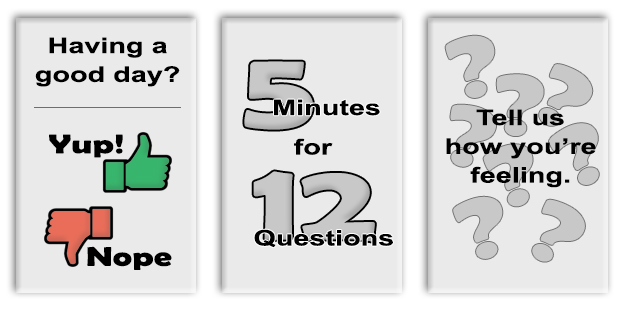“Everyone takes surveys. Whoever makes a statement about human behaviour has engaged in a survey of some sort.” ~ Andrew Greeley
Last time we talked about the problems with employee engagement surveying. Today we look further at how we can do it differently and how we can implement the changes.
So last time we we finished up talking about transnational customer surveying and wanting to do the same for employees. “But wait” you might say, “employees don’t interact with the company like that.” True, they don’t ring in to use the services, or visit the site to purchase products. However, we can look at their transactions as being a day’s work. With this in mind I think it’s entirely reasonable to ask them how that went.
Now, for people managers I’m sure the concept of asking staff how they’re feeling is hardly blowing their mind (though I can think of some!) This is the very core of the concept though, good managers ask this will ask because they know that this benefits the employee, themselves and the company. Not just because problems can be identified and (possibly) resolved but because simply the act of asking raises engagement – see question 5 above.
That staff are asked if they’re having a good day by their manager is great but we’re analysts here* and we want numbers, damnit! So why don’t we make this a part of our data gathering exercise? Not to take away the need for managers to ask but to allow staff to let the company know directly. Companies often have staff recognition & reward schemes and hopefully all have grievance procedures for when things go wrong, but we generally don’t measure the day-to-day pulse of how well the staff are getting on.
The title image for this post is a sketch of how this could look for the employee. If this were available through the staff intranet or the like then they could quickly give a yes/no answer to show if their day is going well. The second panel takes them to a questionnaire with the 12 questions discussed earlier. The last box can go one of two ways (or both) to either a more comprehensive survey or to a verbatim feedback field.
If this is in place then all employees have the facility to give any level of feedback any day. Sure, there’s a balance of how often is appropriate that needs to be managed. You might want to let someone know they are perhaps over-contributing if they do a full survey every day. Likewise reminding people that the facility exists as appropriate to keep submissions coming would be advisable.
None of this addresses the concerns of staff around how the data will be used. Particularly the issue of maintaining honesty in the feedback. So how do you both assure staff of their anonymity and also make the data relevant and accurate? I say you can’t.
Now, obviously I’m not giving up on the idea completely but there will always be suspicion and the more relevant the data (the more you can relate it to granular elements of your organisation) the more suspicion people will naturally have. You can’t have it both ways at the same time.
However, you don’t need to choose. A fully anonymous system might be honest but no granularity is severely limiting for driving insight and improvement. A fully granular system lets you target change and delve deeply into the data but loses honesty and anonymity has gone. Similarly, any compromise leaves you limited in both areas, a true situation of neither requirement being met.
However, what if you let the employee choose their own level of anonymity when they submit? If you’re gathering this through an intranet then when staff hit the survey age they know full well that “you know who they are” they’re logged in. However, if you show the organisation structure above them when they go to provide their responses they could then say at which level they want to be identified. Maybe they’re quite happy to have their feedback associated with them; then they can put their name against it. Not happy with that? Maybe just put your team, or department, or division. No? Okay, “I’m an employee and I feel this way” is fine.
What does this give us? Well, as well as, providing the user with some control it also provides another set of measures. The degree to which staff are prepared to associate themselves personally to their responses is an indication in itself of their trust and engagement with the company.
So, with the approach I’ve outlined here we can see how we can put three forms of control into the hands of the staff members filling out the survey:
- Frequency – When and how often to provide data (within limits)
- Detail – How much time to spend and information to give
- Anonymity – How tightly their responses are associated to them
With correct implementation these methods can address the issues outlined at the start of this article.
I’ve not addressed anything around the value of the data that comes out of the surveys. How an understanding of engagement can enhance the performance of a business but That’s a blog for another time, this one has already run more than a little long, even with much detail only briefly addressed or omitted.
Hopefully this gives you some ideas about how engagement surveying can be done differently. I’d love to know what you think. Would this be best implemented internally or as an external online service? How do you think employees can be sufficiently encouraged to share how their day is going? Leave a note in the comments, start a conversation.
* I’m making a gross assumption of curse. If you’re not an analyst then welcome, I hope you’re well and aren’t feeling too uncomfortable here.
